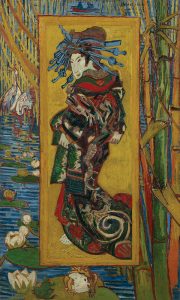Vincent van Gogh – The Arlésienne (Marie Ginoux), 1888
The Metropolitan Museum of Art, New York, Bequest of Sam A. Lewisohn
From 1639 to 1854, the Netherlands was the only Western country permitted to trade with Japan. It meant that the Dutch were already acquainted with Japanese artworks in the late 19th century when a rage for collecting them began. Hitherto unseen works of Kanagawa (Under The Wave) Hiroshige and other Japanese print makers had a powerful and lasting influence on Western aesthetics.

The first of these shows the impact this ‘new vision’ had on Van Gogh’s art. The artist became fascinated by the ‘floating world’ or ukiyo-e – as depicted in 19th century Japanese woodcuts. He collected many prints before leaving Paris for Arles. The unconventional compositions, large planes in bright colours and focus on details in nature were all explored and he continued to see with a ‘Japanese eye’ to the end of his life. Such works include the famous Almond Blossom painted in 1890 for his brother Theo and his wife Jo’s baby son, also called Vincent.
A sister show, Mesdaq & Japan, introduces the visitor to Japanese artifacts admired and collected by seascape artist Hendrik Willem Mesdaq.
Until June 17th at the Van Gogh Museum, The Hague, Netherlands
Vangoghroute.com
